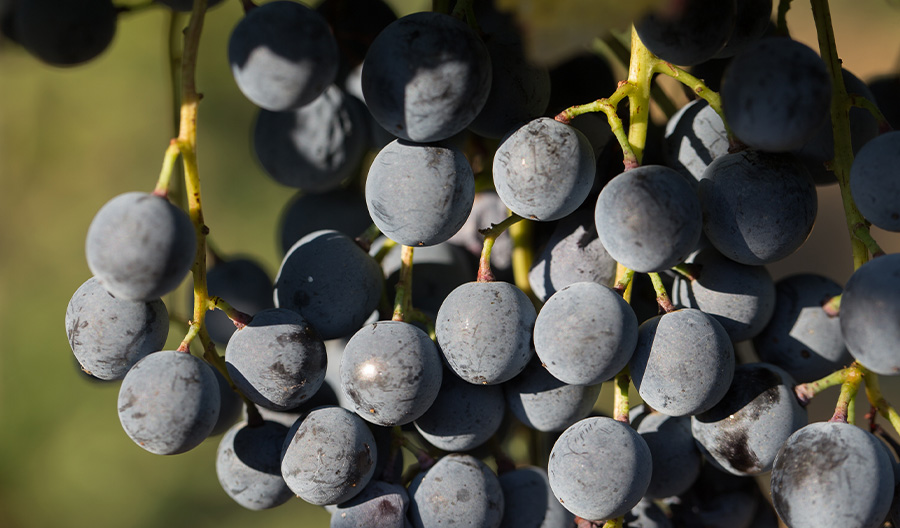Don’t call it a comeback—Lambrusco is the OG of alternative sparkling wine. The wild family of grapes known as Lambrusco, native to Emilia-Romagna and southern Lombardy, has been glorified by the likes of Virgil, Cato and Pliny the Elder, each highlighting the delicious and unique character of this boisterous family of different, but related, varietal types. There are references to early Romans fermenting the wine in amphorae—and we begin to see documentation of bottled sparkling wine made from the various Lambrusco grapes in the 1800s.
Today, thanks in part to the rise of pét-nat’s popularity, funky sparklers are becoming a trend—and Lambrusco has a 200-year head start. Today’s iterations have more character and freshness than was commonplace in the past. But Lambrusco is still fighting its 1970s and ’80s reputation as a simple, fizzy, sweet red wine produced by large cooperatives and commodity producers.
In truth, there are many styles of Lambrusco—from bone dry to sweet, slightly fizzy to full-on bubbly, bright white to the inkiest purple in color.
Back in the ’70s and ’80s, those mass-producers of Lambrusco used the Charmat (tank) method to create their sweet, fizzy wines. The Charmat method is still used today, but more thoughtfully: With Charmat you can recognize the purity of fruit of the variety, you preserve freshness and fruitiness, if made in a serious manner. Lambrusco made in the Charmat method jumps out of the glass—they are forward and upfront about their fruitiness: sour cherries and pomegranate if using Sorbara; ripe and juicy black plums if made from Grasparossa. They are fun, inviting, delicious and easy wines, wines meant for the moment.

Prior to the introduction of Charmat, in the 1960s, producers of the region created bubbles either via the ancestral method or rifermentato. Today, the terms are used somewhat interchangeably but technically they are different. The ancestral method is one fermentation done in two parts. The producer will press the grapes, begin fermentation, but while it is still fermenting and has sugar, they bottle the wine and fermentation continues in bottle, trapping the CO2 and making bubbles. This is making one of the most difficult wines in the world if you do not manage the wine correctly. It is not an easy project.
Rifermentato, on the other hand, is seen as the more historic method of the region. Traditionally, they kept a part of their must and in spring they would bottle the finished wine with a little of that must, which would promote the next fermentation, or rifermentato. But it wasn’t until the mid-1990s that small family farms began to reintroduce rifermentato around Modena and Parma, catching the attention of top restaurants, importers and, maybe more importantly, other producers within the Lambrusco production areas.
Wines made via rifermentato or ancestral method highlight the core of fruit found in the grapes of the Lambrusco family, but provide more nuance, specificity, depth and textural expression. The wine’s bubbles (or perlage) tend to be finer, the tannins more refined— you feel more of the wine. It is like the difference between playing Chopsticks versus Bach on the piano. There are just more notes.
A growing number of producers are making Lambrusco using the classic (or Champagne) method, with extended lees aging and a slightly higher pressure. This creates a wine with heightened secondary aromas of flowers, earth and even cured meat and produces very fine, persistent bubbles. Fabio Lini of Lini 910 is one of the pioneers in traditional method Lambrusco who began experimenting with the process in the 1970s due to his love of Champagne. After decades of work, the Lini family introduced a 100% Salamino Lambrusco made via the classic method and it was a smash hit. The family ages the wine on the lees for many years with the current vintage being 2007. It’s a miracle in the Lambrusco world to have a wine aged for 16 years in the bottle before release, but this shows the passion and the enological capabilities behind Lambrusco.
This push for quality and search for unique expressions of the Lambrusco family of grapes is only moving quality higher and giving the world what it wants. Each method used to achieve putting bubbles in the wine has its place, gives it its own personality, expression and purpose. The beauty of Lambrusco is in that diversity.

